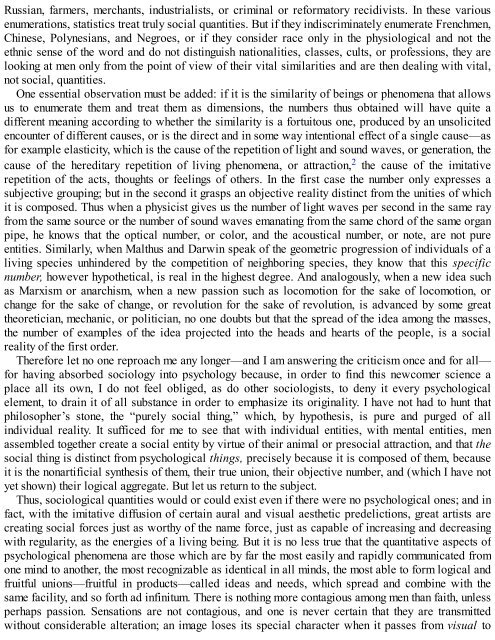3658925934
Create successful ePaper yourself
Turn your PDF publications into a flip-book with our unique Google optimized e-Paper software.
Russian, farmers, merchants, industrialists, or criminal or reformatory recidivists. In these various<br />
enumerations, statistics treat truly social quantities. But if they indiscriminately enumerate Frenchmen,<br />
Chinese, Polynesians, and Negroes, or if they consider race only in the physiological and not the<br />
ethnic sense of the word and do not distinguish nationalities, classes, cults, or professions, they are<br />
looking at men only from the point of view of their vital similarities and are then dealing with vital,<br />
not social, quantities.<br />
One essential observation must be added: if it is the similarity of beings or phenomena that allows<br />
us to enumerate them and treat them as dimensions, the numbers thus obtained will have quite a<br />
different meaning according to whether the similarity is a fortuitous one, produced by an unsolicited<br />
encounter of different causes, or is the direct and in some way intentional effect of a single cause—as<br />
for example elasticity, which is the cause of the repetition of light and sound waves, or generation, the<br />
cause of the hereditary repetition of living phenomena, or attraction, 2 the cause of the imitative<br />
repetition of the acts, thoughts or feelings of others. In the first case the number only expresses a<br />
subjective grouping; but in the second it grasps an objective reality distinct from the unities of which<br />
it is composed. Thus when a physicist gives us the number of light waves per second in the same ray<br />
from the same source or the number of sound waves emanating from the same chord of the same organ<br />
pipe, he knows that the optical number, or color, and the acoustical number, or note, are not pure<br />
entities. Similarly, when Malthus and Darwin speak of the geometric progression of individuals of a<br />
living species unhindered by the competition of neighboring species, they know that this specific<br />
number, however hypothetical, is real in the highest degree. And analogously, when a new idea such<br />
as Marxism or anarchism, when a new passion such as locomotion for the sake of locomotion, or<br />
change for the sake of change, or revolution for the sake of revolution, is advanced by some great<br />
theoretician, mechanic, or politician, no one doubts but that the spread of the idea among the masses,<br />
the number of examples of the idea projected into the heads and hearts of the people, is a social<br />
reality of the first order.<br />
Therefore let no one reproach me any longer—and I am answering the criticism once and for all—<br />
for having absorbed sociology into psychology because, in order to find this newcomer science a<br />
place all its own, I do not feel obliged, as do other sociologists, to deny it every psychological<br />
element, to drain it of all substance in order to emphasize its originality. I have not had to hunt that<br />
philosopher’s stone, the “purely social thing,” which, by hypothesis, is pure and purged of all<br />
individual reality. It sufficed for me to see that with individual entities, with mental entities, men<br />
assembled together create a social entity by virtue of their animal or presocial attraction, and that the<br />
social thing is distinct from psychological things, precisely because it is composed of them, because<br />
it is the nonartificial synthesis of them, their true union, their objective number, and (which I have not<br />
yet shown) their logical aggregate. But let us return to the subject.<br />
Thus, sociological quantities would or could exist even if there were no psychological ones; and in<br />
fact, with the imitative diffusion of certain aural and visual aesthetic predelictions, great artists are<br />
creating social forces just as worthy of the name force, just as capable of increasing and decreasing<br />
with regularity, as the energies of a living being. But it is no less true that the quantitative aspects of<br />
psychological phenomena are those which are by far the most easily and rapidly communicated from<br />
one mind to another, the most recognizable as identical in all minds, the most able to form logical and<br />
fruitful unions—fruitful in products—called ideas and needs, which spread and combine with the<br />
same facility, and so forth ad infinitum. There is nothing more contagious among men than faith, unless<br />
perhaps passion. Sensations are not contagious, and one is never certain that they are transmitted<br />
without considerable alteration; an image loses its special character when it passes from visual to









![Genki - An Integrated Course in Elementary Japanese II [Second Edition] (2011), WITH PDF BOOKMARKS!](https://img.yumpu.com/58322134/1/180x260/genki-an-integrated-course-in-elementary-japanese-ii-second-edition-2011-with-pdf-bookmarks.jpg?quality=85)
![Genki - An Integrated Course in Elementary Japanese I [Second Edition] (2011), WITH PDF BOOKMARKS!](https://img.yumpu.com/58322120/1/182x260/genki-an-integrated-course-in-elementary-japanese-i-second-edition-2011-with-pdf-bookmarks.jpg?quality=85)





